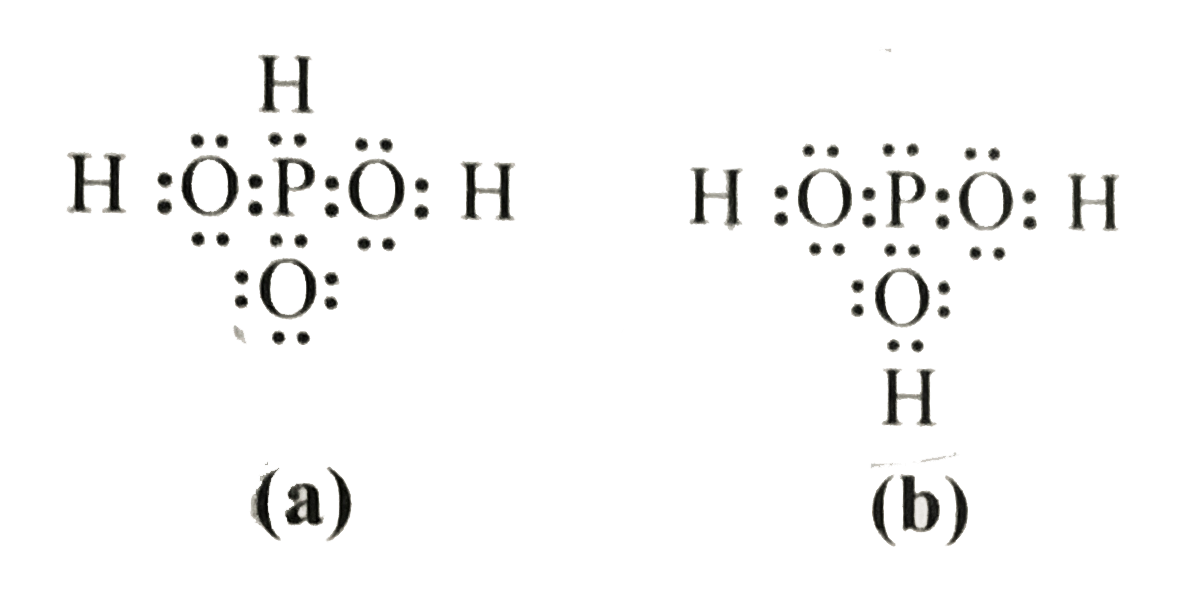H3PO3 can be represented by structures I and II shown below. Can these two structures be taken as the canonical forms of the resonance hybride representing H3PO3? If not, give resonance hybrid representing H3PO3? If not, give reasons for the same.
To determine whether the two structures of H3PO3 can be considered as canonical forms of the resonance hybrid, we need to analyze the characteristics of resonance structures and the provided structures.
1. Identify the Given Structures:
- Let's denote the two structures as Structure I and Structure II.
- Structure I has a hydroxyl group (-OH) and a double bond to oxygen (C=O).
- Structure II has a different arrangement of the hydroxyl groups and the double bond.
2. Check Atom Positions:
- In resonance structures, only the positions of electrons can change, not the positions of atoms.
- If the positions of atoms change between the two structures, they cannot be considered resonance forms.
3. Analyze Structure I and II:
- In Structure I, the hydrogen atom is bonded to an oxygen atom, while in Structure II, the hydrogen atom is bonded to phosphorus.
- Since the position of hydrogen changes between the two structures, this indicates that they cannot be resonance forms.
4. Conclusion on Canonical Forms:
- Since the structures involve a change in atom positions (hydrogen moving from oxygen to phosphorus), they cannot be considered canonical forms of a resonance hybrid.
- Therefore, the answer is that these two structures cannot be taken as canonical forms of the resonance hybrid representing H3PO3.
5. Construct the Resonance Hybrid:
- To represent the resonance hybrid of H3PO3, we can draw a structure where the double bond between phosphorus and oxygen is delocalized.
- A possible resonance hybrid can be represented as:
- H2O bonded to phosphorus, with one double bond to oxygen and the other oxygen having a negative charge, while phosphorus carries a positive charge.
- This structure reflects the delocalization of electrons without changing the positions of the atoms.
Final Answer:
The two structures cannot be considered canonical forms of the resonance hybrid representing H3PO3 because they involve a change in the position of atoms, which is not allowed in resonance structures. The correct resonance hybrid involves delocalization of electrons while keeping the atomic positions fixed.
---
- Let's denote the two structures as Structure I and Structure II.
- Structure I has a hydroxyl group (-OH) and a double bond to oxygen (C=O).
- Structure II has a different arrangement of the hydroxyl groups and the double bond.
- In resonance structures, only the positions of electrons can change, not the positions of atoms.
- If the positions of atoms change between the two structures, they cannot be considered resonance forms.
- In Structure I, the hydrogen atom is bonded to an oxygen atom, while in Structure II, the hydrogen atom is bonded to phosphorus.
- Since the position of hydrogen changes between the two structures, this indicates that they cannot be resonance forms.
- Since the structures involve a change in atom positions (hydrogen moving from oxygen to phosphorus), they cannot be considered canonical forms of a resonance hybrid.
- Therefore, the answer is that these two structures cannot be taken as canonical forms of the resonance hybrid representing H3PO3.
- To represent the resonance hybrid of H3PO3, we can draw a structure where the double bond between phosphorus and oxygen is delocalized.
- A possible resonance hybrid can be represented as:
- H2O bonded to phosphorus, with one double bond to oxygen and the other oxygen having a negative charge, while phosphorus carries a positive charge.
- This structure reflects the delocalization of electrons without changing the positions of the atoms.
The two structures cannot be considered canonical forms of the resonance hybrid representing H3PO3 because they involve a change in the position of atoms, which is not allowed in resonance structures. The correct resonance hybrid involves delocalization of electrons while keeping the atomic positions fixed.
Topper's Solved these Questions
- CHEMICAL BONDING AND MOLECULAR STRUCTUREBOOK - MODERN PUBLICATIONCHAPTER - CHEMICAL BONDING AND MOLECULAR STRUCTUREEXERCISE - NCERT (Exemplar Problems) (Multiple Choice Questions (Type-I))
22 Videos
- CHEMICAL BONDING AND MOLECULAR STRUCTUREBOOK - MODERN PUBLICATIONCHAPTER - CHEMICAL BONDING AND MOLECULAR STRUCTUREEXERCISE - NCERT (Exemplar Problems) (Multiple Choice Questions (Type-II))
8 Videos
- CHEMICAL BONDING AND MOLECULAR STRUCTUREBOOK - MODERN PUBLICATIONCHAPTER - CHEMICAL BONDING AND MOLECULAR STRUCTUREEXERCISE - Conceptual Questions (3)
13 Videos
- CLASSIFICATION OF ELEMENTS AND PERIODICITY IN PROPERTIES BOOK - MODERN PUBLICATIONCHAPTER - CLASSIFICATION OF ELEMENTS AND PERIODICITY IN PROPERTIES EXERCISE - UNIT PRACTICE TEST
13 Videos
Similar Questions
Knowledge Check
H3PO3 is
AA tribasicBA dibasicCA monobasicDNeutralH3PO3 is
AA tribasic acidBA dibasic acidCNeutralDA monobasic acidIn H3PO3 molecule
AP-atom is surrounded by three -OH groupsBP-atom is tetrahedrally surrounded b two -OH groups, one oxygen atom and onee hydrogen atomCP-atom is surounded by four -OH groupsDP-atom is surrounded by two -H atoms

